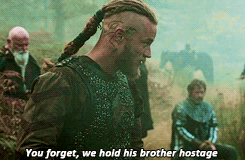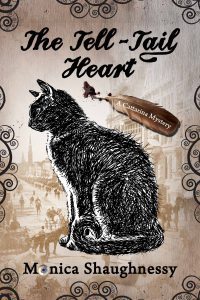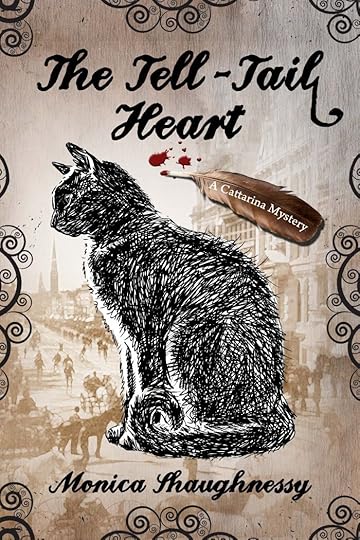Monica Shaughnessy's Blog, page 6
July 25, 2014
I Gave Up Hope (And I Feel So Much Better)
 This might seem strange to you, but I gave up hope a few weeks ago, and I’ve never felt better. Let me explain.
This might seem strange to you, but I gave up hope a few weeks ago, and I’ve never felt better. Let me explain.
I’ve been toiling away at the profession of writing now for over a decade, and I don’t have much to show for it. Here is where others would tell you about their multi-book contracts or Pushcart Prizes or professorial gigs. Yet here is where I come up empty. Don’t get me wrong. I’ve had my successes (I won’t bore you with them.) But chances are, you’ve probably never heard of me outside this blog.
During the last decade, I spent a lot of time “hoping” for things that never came. If you’re a fellow writer (no matter how successful or unsuccessful), I’m sure you’ve been there. Heck, if you’re a citizen of Planet Earth, I’m sure you’ve been there. We all hope for things in our daily lives–a better career, a better car, a better cup of coffee. Some of them come. Some of them don’t.
On vacation, I had the mental space to “get away” from my day to day problems: can I finish that short story? should I book this promotion? is that cover in need of changing? Ack! So I picked up a book on Zen Buddhism (a subject I’ve studied before) to calm myself, and I read a chapter on hope vs. aspiration. Here is what I learned:
Hope is the domain of the future. It is out of our control. We are powerless to change it or affect it. It is dashed again and again when it slips from our grasp. Hope is for dreamers.
Aspiration is the domain of NOW. It is within our control, completely and entirely. It never fails because an aspiration is just that, an acknowledgement that you are moving in a particular direction. If you didn’t reach your goal today, then you will continue to “aspire” tomorrow. Aspiration is for doers.
At the risk of boring you with a cliche, the proverbial light switch flipped on in my head. I woke up from my “dream of hope” and turned to the power of aspiration. This meant reframing many of my thoughts. I no longer “hope to make full time money” from my writing. I aspire to make a living from my writing. Have I achieved it today? No. Then I will work a little harder tomorrow. I no longer “hope to get a big readership.” I aspire to create a large following. Have I achieved it today? No. Then I will try something new tomorrow. It’s a way of looking at those things in your life that you’d like to change or make different, but in a way that does’t make you crazy or depressed or “hopeless” when they don’t happen.
Like I said before, aspiration is not just for writers. Don’t “hope” to get a better job one day. Aspire to have a different career, each and every day you wake up. Don’t “hope” for a better relationship with your significant other. Aspire to create harmony, each and every day. (or aspire to find a new man/woman!)
By reframing these “hopeful” thoughts into aspirations, we feel more powerful, more in control, and the motivation to do something about them springs forth. And when we’re crawling into bed at night to assess how close we have or have not come to these goals, that feeling of despair disappears when we realize that we will not be any worse off than before if we did not achieve magic. We will still be “aspiring” to greatness.
And that’s not a bad place to be.
——————–>
How about you, dear readers? Have you struggled with hope before? Has yours ever been dashed? How did you pick up the pieces and carry on? I’d love to hear from you!


June 23, 2014
Breathing Life Into Poe
When I decided to write a cozy mystery series starring Edgar Allan Poe and his cat, Cattarina, I knew without a doubt that I couldn’t write from the perspective of Poe. Because to do so would’ve meant accessing his genius - an impossible task for most writers. There will never be another like him, and I do not think anyone truly capable of knowing his mind. And while he’s one of the main characters of The Tell-Tail Heart, his motives are implied throughout the story. Even his dark moods are left open for interpretation by the reader.
Poe’s time in Philadelphia was creatively abundant. He moved about the city, almost like a gypsy, for one reason or another. Perhaps he traded too many times on the good favor of his landlords. Or, as I tend to think, he wanted to provide fresh, new air for his consumptive bride, Virginia.
In 1842, he lived down the block from the Eastern State Penitentiary. The building is now a ruin, but in Poe’s time, it was a model of reform. Based on Quaker theories of repentance, prisoners were not allowed to speak, not even to guards. Meals were served through slits in the door. There was no communal time. Even for walks across the compound, the prisoners had to wear hoods to minimize personal interaction. This solitary confinement lasted for the duration of a man’s sentence and drove many crazy. There were opponents to this method, including Charles Dickens. He visited the facility in 1842 and met Poe during this time.

Eastern State Penitentiary
One can only imagine the creepy inspiration the building gave Poe for his stories. Eastern State is a featured landmark in my first book, The Tell-Tail Heart, along with the Fairmount Water Works (another post! another time!).
Around the spring of 1843, Poe moved to the Eastern Spring Garden district in Philly. This house, now owned by the National Park Service, is still in existence, albeit in different form. Some early descriptions paint Poe’s home as a “lean-to” against his landlord’s home – a far cry from the stately brick structure that stands today. Was it rebuilt after Poe left? Or was the “lean-to” remark a back-handed insult by someone of lesser renown? We may never know. If you’re a Poe expert and know the answer, I’d love to hear it in the comments.
Later that year, Poe moved to New York and published “The Raven” to great acclaim. Though some of his dreams fell through – including a literary magazine he tried to get off the ground - many came true. But it was the time leading up to this success that I found so fascinating. Outside of an editorial job at Graham’s Magazine, he struggled greatly in Philly. It was here, in this great city, that his wife became ill with TB, and it was here that he made his greatest enemy, the Rev. Rufus Griswold. It was also here that he penned “The Murders in the Rue Morgue,” among other great tales. Some even think he began “The Raven” while in the City of Brotherly Love.
And let’s not forget his tortoiseshell cat, Cattarina. She kept him company throughout his time in Philadelphia and moved with him to New York. Correspondence tells of their great relationship. Cattarina would even sit on Poe’s shoulder while he wrote, no doubt supervising his efforts! You can read more about their life together in my cozy series. Book One, The Tell-Tail Heart, is currently out, and Book Two, The Black Cats, is slated for release this summer.
I will leave you with this last tidbit about Poe: he was the first American writer to try and make a living solely off his writing.
Poe may have much in common with today’s writer, but his genius is matchless.
—————->
Calling all Poe fans! I’d love to hear your thoughts about his time in Philadelphia. What are your favorite Poe stories?


June 11, 2014
You Might Need an Editor If…
Just wrote this post over on the Space City Scribes blog. Enjoy!
 Originally posted on Space City Scribes:
Originally posted on Space City Scribes:
by Monica Shaughnessy
I love Jeff Foxworthy. Since I grew up redneck, I always find his humor to be spot-on and terribly funny:
So when it came time for me to do this post, I just had to use a writerly version of his now-famous routine. Without further delay, I give you my list. If you see yourself on it, don’t cringe (okay, cringe a little), seek help instead. :-) If you see one of your friends on this list, send them a link to my post (if you dare).
You Might Need an Editor If…
your picture book has nude scenes.
your middle grade novel has more chapters than the bible
you don’t get the whole apostrophe thing
your critique group spends more time correcting your story than you did writing it
the main character in your YA novel is a thirty-eight year old man with shingles
your historical novel takes place on a…
View original 395 more words


April 30, 2014
Is Kid Lit Behind the eCurve? / Blog Hop
 It’s no secret that mysteries, thrillers, and romance novels are exploding in ebook form. But the great wave of digital kid lit readers has yet to reach the shore.
It’s no secret that mysteries, thrillers, and romance novels are exploding in ebook form. But the great wave of digital kid lit readers has yet to reach the shore.
Three years ago, I found out my daughter’s school was going to allow kids to bring ereaders to class. I was ecstatic! As a children’s book writer who’d recently taken the indie plunge, I felt like my potential audience was about to double or triple. Well, it didn’t. All those Kindles, iPads and phones kids are bringing to class? They’re using them as calculators, handy research tools, cameras…anything but an ereader. And at home? App-city, baby.
And then there’s the challenge of being an indie author. Parents are willing to take a chance on self-pubbed books for themselves, but they are much more careful with what their children read. And I can’t blame them. Call me elitist, but if the author hasn’t been vetted by “the system,” I’m going to have to vet them myself (and who has the time?). I’ve read too many reviews of indie middle grade books where the main characters cuss (?!?). Is the system perfect? No, not by a long shot. Are there some really awesome indie books out there? You betcha. But it’s another hurdle to jump.
But don’t think my daughter doesn’t read. She DEVOURS books. It’s just that 90% of them are physical. Still. Even though her mother writes ebooks. Hmmm… Kids are the most tech-savvy people on the planet. Ask any six year old, and I’ll bet they can reprogram your phone. But read a book on that thing? Nah. I know, I know…there ARE kids who read on ereaders–especially if all they have is an old school Kindle that can’t access the internet. But numbers don’t lie. One look at Hugh Howey’s author earnings report and that measly 3% tells you everything you need to know. (scroll down and look at the first pie chart)
So last year, I sat on that dry, dry beach, waiting for the wave that never came. It was then that I decided to reinvent myself as a mystery writer for adults, despite my great interest in kid lit. There’s a market for adult mysteries. Readers are ready and waiting for material. New waves are available daily.
Oh, I still write children’s books. I just released a picture book last month (The Easter Hound) and I’m noodling around with Doom & Gloom Book 2. But it’s a labor of love, not something I do to, you know, make money. Will I ever quit writing kid books? Yes, when I run out of ideas, which will happen…never.
Now! Since this post is a part of a blog hop, I need to answer four questions about my writing process, after which I will introduce you to three great authors. Vivian Kirkfield was kind enough to invite me along for the hop. You should definitely go check out her site when you have the time. She has lots of great advice for writers and the occasional giveaway.
What am I working on now?
I am outlining my next adult mystery, The Black Cats (Book 2 in the Cattarina Mystery series). As for my “kid project,” I am half-way through illustrating a zany chapter book I wrote a few years ago. I hope to release both in time for summer reading.
How does my work differ from others in my genre?
My work tends to be outside the mainstream. So if you’re looking for something a little off-beat, you’ve come to the right place. When I bring a new project to my critique group, they normally say, “How on earth did you come up with THAT idea?” (they mean this in the best way possible…I think) Anyway, my books are full of characters who doubt themselves, who question convention, who reach higher, and who sometimes succeed. There are no easy answers in my books.
Why do I write what I do?
Because I can’t, just CAN’T, write what everyone else is writing. If it’s already been done, why do it again?
How does my writing process work?
For novels, I have to think about them for weeks before I begin writing, mull them over, hash them out. I like to have a solid direction before I even start page one. Letting the plot germinate helps me immensely. For picture books, I wait for inspiration to strike and get them down on paper when they arrive in a flash. This usually happens two or three times a year, and always when I’m doing something completely removed from writing.
Now! Let me introduce you to three awesome kid lit authors you should definitely check out. Two have physical books available and one has eComics for kids.
Dee Leone - Dee Leone enjoys writing fiction, non-fiction, and silly verse. She has written several reproducible books for the educational market, covering themes such as science, language arts, and holidays. The author taught at the elementary level in several states and was also a gifted program aide. Her interests include amateur photography, traveling, and scrapbooking.She also enjoys devouring books and chocolate. Her leveled reader, Bizz and Buzz Make Honey Buns (Grosset & Dunlap/Penguin) has a June 26, 2014 release date and is available for pre-order. Free worksheets can be found on Dee’s website.
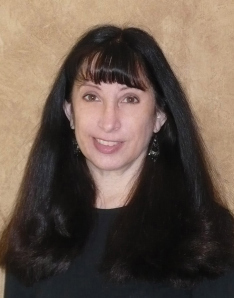
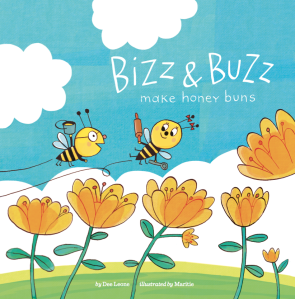
Website: deeleone.com
Book Website: bizzandbuzz.weebly.com
Twitter: @DeeLeone3
DeeDee Andrews - DeeDee Andrews worked for many years in Marketing and Graphic Design for a manufacturing company. She created catalogs and advertisements that made industrial widgets and gizmos look cool. Through marketing she was given the opportunity to travel the world. Eventually DeeDee married and became the mother of twin boys. After their twins had too much fun in first grade and didn’t learn anything, DeeDee and her husband decided to home-school. During that 7 year home-schooling period the “Domino Park Comics” were born. Drawing on a life time love of comic books and newspaper comic strips, and DeeDee’s Graphic Design background, she drew comic strips to encourage her kids to read. She began her blog in January 2014 and feels she is still in the process on introducing herself. Her house is filling with crazy sketches and scraps of paper with wonderful ideas for the blogs and books. The fun is just beginning. Her comic books are available at Amazon, here and here.
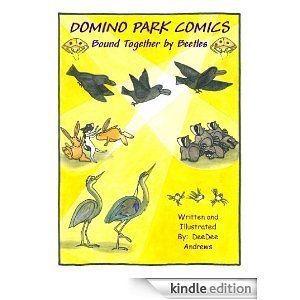
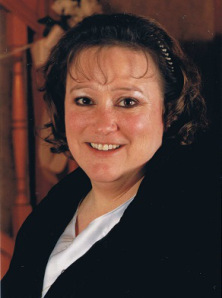
Blog Link: http://dominoparkcomics.com/
Ellen Rothberg - Ellen Rothberg spends most of her days as an elementary school guidance counselor in Sugar Land, Texas, which affords her the opportunity to gain insight into what makes today’s kids tick. Along with that knowledge comes the irresistible urge to share the funny and sometimes prophetic things they do. By fictionalizing their best traits (and some of their not-so-best traits), she often creates works that entertain and teach at the same time. Her works of fiction include the Sue Ellen series of picture books, Don’t Eat the Bluebonnets, Hayfest, A Holiday Quest, and Bully in the Barnyard, all written with co-author, Ellen Leventhal. The Ellens are currently working on a middle grade chapter book that, again, invites a glimpse into a child’s very humorous attempts to make his world a better place.
You can buy their books here.
Stop by the Ellens’ website at http://www.E2books.com or visit E2 Books on Facebook.
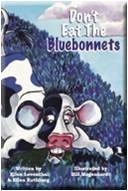
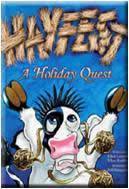
————————–>
If your kid lit books are catching fire on Amazon, please write a comment and let me know the secret to your success. I’d love to be wrong, especially about something like this! OR, if you tend to agree with me, tell me about your experiences.


April 20, 2014
The Terrifying Act of Sharing Your Art
I visited the natural science museum yesterday with my daughter, and, as we sometimes do, we brought our sketching supplies. We headed straight for the butterfly habitat–a lovely glass building filled with prehistoric-looking plants and hundreds of winged creatures–and began to draw. Within a few minutes, a mother and her two children passed by. Then they passed by again. On her third trip, she stopped and asked if she could show her children the sketch I was making. She said she knew it was a work in progress, but that it was lovely and she wanted her kids to see it.
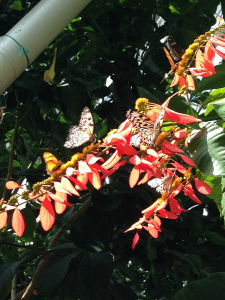
The Subject
I nearly fell off my seat.
Quite calmly–as if this sort of thing always happened to me–I turned the sketch around and talked to the kids about what I was drawing. They listened, nodded in appreciation, then shuffled away down the path. For them, this was nothing more than a thirty-second connection to a stranger, a passing glance at someone’s else’s creation. For me, however, it was a turning point.
After ten years of writing, I’ve grown somewhat confident in my ability to tell a story and arrange words. I say “somewhat” because that fear never really goes away. I’m sure some authors have gotten past it (Stephen King?). But I still get those little palpitations when I upload. Will the story pass muster? Will people like it? And, because you can’t please everyone, will the people who dislike it hate it enough to rip it to shreds? Blah, blah, blah. In the end, though, if I wasn’t sure I’d written an entertaining story with a tight plot and well-turned sentences, I wouldn’t have published it in the first place. My illustrations, however, are a different story.
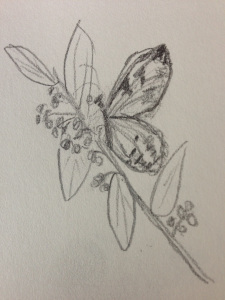
The Sketch – a quick, simplistic pencil drawing
As with my writing, I’m a self-taught artist. I come by the talent naturally, having received it from my mother and grandmother. And while it will never, ever stand up to the greats like Picasso or Rembrandt, my work is passable. My paintings hang in my home, proudly displayed, and many a time I’ve perused art festivals with a knowledge that I could’ve created something of similar aptitude. But I’d never made the move to sell my art until I wrote and illustrated The Easter Hound. A week after I published it, I called my mother–in a cold sweat, no less–and asked her if I’d embarrassed myself with this book. She assured me I hadn’t. But then again, she is my mother. This wasn’t exactly the proof I needed.
And then yesterday, a complete stranger liked my art well enough to stop and ask me about it. This, in case you haven’t figured out by now, was a big blinking neon sign that I should stay on this new avenue and further develop my skills. I won’t give up creating stories, of course. But it thrills me to know that, if need be, I can accompany them with the occasional illustration. Will my work ever hang in a museum? Nah. Will it amuse a few people? Only time will tell.
Do you sing, but only in the shower? Do you secretly draw without showing anyone? Do you journal for an audience of one? Do you dance when no one is watching?
If you have a talent that never sees the light of day, try sharing it with someone else today. It can be a terrifying experience. But things always grow best in the sun.
—————————->
Your turn. Ever created something that you were afraid to show anyone else? Tell me about your first time publishing or your first time exhibiting your art. I’d love to hear about it.


April 11, 2014
What Would Ragnar Do? (WWRD)
If you’re not watching History Channel’s Vikings, then you’re missing out on a heck of a show. I don’t gush about many, but this one deserves it. The drama is riveting, but Ragnar Lothbrok, the main character, makes it addictive. Based on a real historical figure of the same name, Ragnar is the quintessential “take no prisoners” Viking who never lets anyone or anything stand in his way.
As a writer, I don’t exactly face down mobs of warring factions during the course of business, but I do encounter the occasional setback. So I thought, what advice would Ragnar give me during these times?
I’m networking on Goodreads today. Any advice?
Ragnar, sales are down in the dumps. People have told me to have patience, but it’s difficult. What should I do?
BookBub turned me down again. How can I get them to accept my book?
I contacted a book blogger, but he passed on my proposal.
My book launch was strong, but now, zip.
I’m waiting on reviews from my latest KDP giveaway. Any advice?
Some days, self-publishing feels like battle. Should I quit?
The next time I find myself floundering, I’ll just ask: What Would Ragnar Do?
——————————>
These awesome gifs were taken from the Tumblr site: http://vikingsgif.tumblr.com If you’re a fan of Vikings or a writer who needs a little Viking strength, give me a shout!


March 31, 2014
Kindle Comic Creator for Picture Book Authors/Illustrators
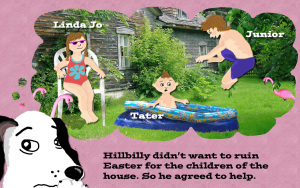
A Panel from The Easter Hound
I just released a book last week (The Easter Hound) using the Kindle Comic Creator (KCC), and it was a breeze. Up to this point, I had delayed jumping into illustrated work because of the digital barriers. It’s true that children’s works do well in printed format, but I didn’t want to begin a project that had absolutely no digital footprint. If you know anything at all about digitizing picture books, then you understand that pictures won’t fit, words may flow to the wrong page, etc, etc. It’s a nightmare! And then I ran across the KCC. This software has been available for awhile, but just hadn’t been on my radar until a few weeks ago.
Let me take you step by step into my process. Once I had a workable manuscript, here’s what I did:
1. Software Installation – In order to install the software on my Mac, I had to download a couple of plug-ins as well, but the process was pretty straightforward. The software is free, by the way. Here’s a link to it.
2. Art Creation – I started this project from scratch using Photoshop Elements. I also have a Bamboo stylus pad that I use to draw with. I went 100% digital, creating the work in Elements from the get go. Some of you may prefer to work in pencil/ink, scan your work, and then trace. That’s cool, too. I set my page size to 1280 x 800 pixels, the maximum size KCC accepts. I decided to create a landscape book, but I could’ve also chosen portrait. There’s also an “un-fixed” mode, where the reader can either hold their device landscape or portrait, but in order to make this work, your artwork would (I’m guessing) either be shrunk down or cut off, depending on how the art was created (unless you developed square-ish pictures). Since I didn’t want those hassles, I picked an orientation and stuck with it. Don’t forget to also make a cover, a title page, and back matter for your copyright info. If you’re already working with existing art, then you’ll have to resize the pages to fit within KCC. They don’t have to be 1280 x 800. They can be any size smaller than this.
3. Dropping in Text - Remember, you’re developing static, unflowable pages. So your text must be placed into your pictures. Since I’d never been both author and illustrator on a project, I found that many of the words I’d put into my story became unnecessary when accompanied by the art. So when you’re writing that manuscript, know that it’s going to shrink since pictures will tell much of your story (or, they should).
4. Formatting - Once I created all my individual pages (the 1280 x 800 canvases) in Elements, I saved them all to jpg format. Then, in KCC, I created a new book. From there, I uploaded a cover and entered in my metadata (author name, publisher, etc.). Then from within the software itself, I “added pages” until I’d loaded all of my jpg’s in the order that I wanted them.
5. Compiling and Previewing – Once my book looked like I wanted it to, I hit the “build and preview” link in the top nav. This built my book into the proper Kindle format. I then scrolled through my book using the Kindle app on my desktop (another piece of software to download).
6. Uploading – When I was ready to publish, I opened up a new project in KDP and uploaded the entire file that the KCC had spit out. Like magic, people.
7. Page previews – I found out the next day that since my project is “fixed” and not moveable the “Look Inside This Book” feature is currently not available (!!!!). So I uploaded the first three pages of my book on the product page (customer photos) to give people an idea of what’s inside. It’s a bummer, but an easy work-around.
The only drawback is that you can’t upload KCC files to Barnes & Noble, Kobo, etc. (duh). BUT! Since all my art is saved in jpg format, I can take those files and compile them using iAuthor (for the Apple Store), import them into Create Space to do a paperback, etc., etc.
Kindle Comic Creator has given me the opportunity to expand my creativity in so many ways. Next, I’m going to illustrate a second picture book and develop a visual reader’s companion for my latest novella, The Tell-Tail Heart, complete with pictures and notes.
If you’re curious about how a picture book looks having been created in KCC (or you’d just like to thank me for this post!), you can buy The Easter Hound on Amazon now for only $1.99.
—————————————–>
How about you? Create any projects in KCC? Been thinking about illustrating in the digital age, but been afraid to take the plunge? I’d love to hear from you!


March 28, 2014
It’s Raining Cats & Dogs
It’s been quite a week. I not only uploaded my cat cozy, but another book as well – The Easter Hound – that I illustrated. Who needs sleep? Now comes the hard part. Marketing.
Without further delay, here are my books:
The untold story behind Edgar Allan Poe’s “The Tell-Tale Heart.”
Philadelphia, 1842: Poe’s cat, Cattarina, becomes embroiled in a killer’s affairs when she finds a clue to the crime: a glass eye. It’s only when her beloved “Eddie” takes an interest, however, that she decides to hunt down the madman. Her dangerous expedition takes her from creepy Eastern State Penitentiary to Rittenhouse Square where she runs into a gang of feral cats intent on stopping her. But new problems arise faster than she can solve them.
As the mystery pulls Cattarina deeper into trouble, even Eddie becomes the target of suspicion. Yet she cannot give up the chase. Both her reputation as a huntress and her friend’s happiness are at stake. For if she succeeds in catching the Glass Eye Killer, the missing pieces of Eddie’s unfinished story will fall into place, and the Poe household will once again experience peace. At the story’s pulse-pounding conclusion, Poe gets the inspiration he needs from his feline muse, enough to finish “The Tell-Tale Heart.”
Full of Victorian witticisms and rich, historical detail, this cozy cat mystery is a fictional account of Edgar Allan Poe’s real-life animal companion. Fans of historical and animal mysteries are sure to like this novella.
Only $2.99 on Amazon!
————————————————
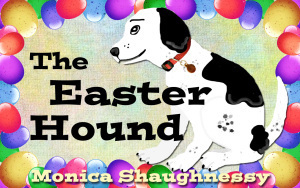 This Easter, Hillbilly Hound is determined to catch the elusive rabbit with the basket and steal goodies for himself. But when Hillbilly sidelines the varmint, he must take over the deliveries before he ruins Easter for the children of the house. What’s a hound to do? After a series of disasters, Hillbilly soon finds that Eastering is best left to the bunny. Full of quirky humor, The Easter Hound is a silly picture book for ages 3 to 5.
This Easter, Hillbilly Hound is determined to catch the elusive rabbit with the basket and steal goodies for himself. But when Hillbilly sidelines the varmint, he must take over the deliveries before he ruins Easter for the children of the house. What’s a hound to do? After a series of disasters, Hillbilly soon finds that Eastering is best left to the bunny. Full of quirky humor, The Easter Hound is a silly picture book for ages 3 to 5.
Only $1.99 on Amazon!
I created The Easter Hound using Amazon’s Kindle Comic Creator, and it was a blast! I had delayed creating digital picture books because of the whole fixed width, sliding text thing. But the software actually made the process quite easy. Now that I have a set of jpg.s, I should be able to compile a second book using iAuthor. I’ll be writing more in the future about using this software and what a Godsend it is for illustrators in the digital age.
If you’ve got a few spare bucks lying around, I hope you’ll buy a book.
Thanks!!!


March 18, 2014
Own It: The Unapologetic Guide to Publishing
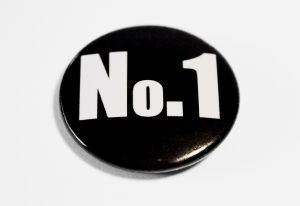 I just finished reading an awesome post by CJ Lyons about being in charge of your own career. As fate would have it, I’d already planned to write a post about this same topic (though from a less wildly successful point of view). So it thrilled me to stumble across it. As creators, it’s important we own our own careers. There are far too many people willing to shove you in the proverbial backseat for a measly nickel. If they’re shoving you in an actual backseat, bookmark this blog, then dial 911 (in that order).
I just finished reading an awesome post by CJ Lyons about being in charge of your own career. As fate would have it, I’d already planned to write a post about this same topic (though from a less wildly successful point of view). So it thrilled me to stumble across it. As creators, it’s important we own our own careers. There are far too many people willing to shove you in the proverbial backseat for a measly nickel. If they’re shoving you in an actual backseat, bookmark this blog, then dial 911 (in that order).
All kidding aside, if you don’t look out for your career, no one else will. Some of you reading this may be pursuing traditional publication. Some of you may be self-publishing. Doesn’t matter. I’ve got an opinion either way. (When have I ever not had an opinion?) But! The blog-o-sphere tends to get touchy when you even hint you’re offering a one-size-fits-all solution. So let me state up front that owning your own career also constitutes ignoring the occasional crackpot (like me). I am in no way telling you to do any of the following. Instead, I hope that what I’ve written makes you think.
Ahem.
How To Be An Unapologetic Traditionalist:
* If you’re just starting out, for heaven’s sake stop telling everyone you’re not published. Also, pre-published. No good, either. Act as if you just scored a deal with Random House, and your confidence will lasso editors from across the room. Whether or not you can hogtie them is an entirely different story.
* For the newly agented, please never, ever say the following: “I’d love to (fill in the blank), but I have to ask my agent for permission first.” Your agent is not your mother. Your agent is your business partner. Act and speak accordingly. And don’t be afraid to talk to them occasionally. You should fear colon cancer instead.
* Books on shelves? Kudos! Just don’t make excuses for your publisher if/when they don’t pull out the stops for your career. If it’s stagnating, you’re the one who suffers. To get an idea of someone who pushed through their Big Pub difficulties, read the CJ Lyons article above. Now that’s owning it.
How To Be An Unapologetic Indie:
* Wondering if you need permission to self publish a book? You don’t. If you’re not convinced, then I’ll give you mine. Happy?
* If you’re just beginning your journey, don’t worry about detractors, especially if your friends are still pursuing the traditional route. Know what makes you a “real author”? Having “real readers” and making “real money” to pay your “real bills” (to the editor, to the proof reader, to the cover designer…)
* Stand behind your book. If you wrote a great story, tell people about it. Act as if your book can hold up to trad pub equivalents, because it should. If it doesn’t, then own those crappy reviews. You earned them.
* If you’re raking in so much cash from indie publishing that you use $100 bills to wipe your tablet screen (lighting cigars with a Benjamin is so 2008), you should be evangelizing, not downplaying your selfie roots. And then lending me a few bills.
That old Frank Sinatra song comes to mind– “I Did It My Way.” Let’s face it. Most of the everyday rewards are given to those who fit in. Standing apart ain’t easy. So if you’ve already accepted the label of “creator,” you’re a bit of a maverick, aren’t you? Apply that same confidence to your books and your career, and own it!
———————————->
Your turn. What does “owing it” mean to you and your career? Ever found your career at the mercy of someone else?


March 8, 2014
Cover Reveal: The Tell-Tail Heart
I’m crazy busy right now and haven’t written a post in nearly two months. (sorry!) But I’ve been finishing up my new novella – The Tell-Tail Heart. It’s a cozy mystery about Edgar Allan Poe’s real-life cat, Cattarina.
Here’s a brief synopsis:
Philadelphia, 1842: Edgar Allan Poe’s cat, Cattarina, becomes embroiled in a serial killer’s affairs when she hunts down an object of fascination to everyone in the Poe household–a glass eye. She involves her beloved Eddie in the mystery and unknowingly provides him with the inspiration he needs to create his own story, The Tell-Tale Heart. Completely fictional account of Edgar Allan Poe’s real life animal companion, Cattarina.
It’s scheduled to publish later this month. I’d love to know what you think of the cover!







